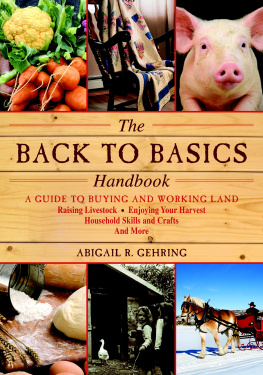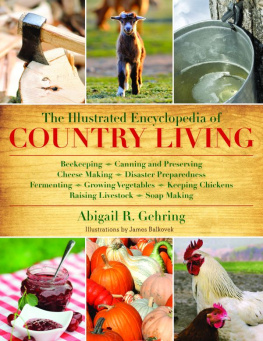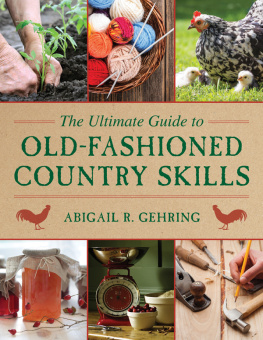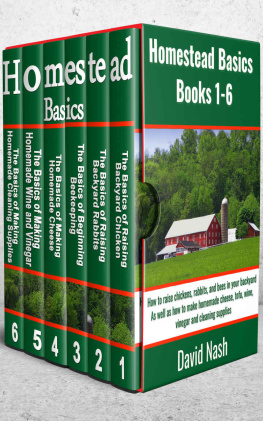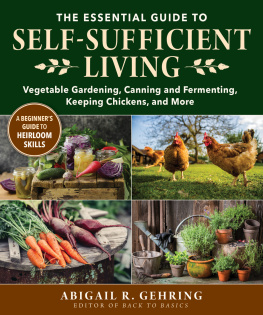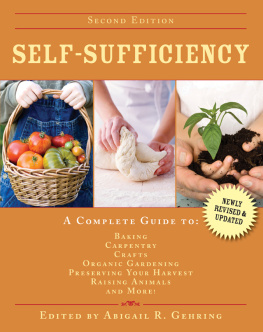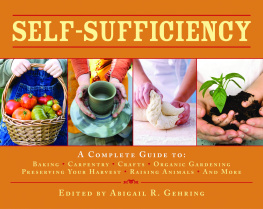Table of Contents
BACK TO BASICS
Copyright 2008 by Skyhorse Publishing, Inc.
All Rights Reserved. No part of this book may be reproduced in any manner without the express written consent of the publisher, except in the case of brief excerpts in critical reviews or articles. All inquiries should be addressed to Skyhorse Publishing, 555 Eighth Avenue, Suite 903, New York, NY 10018.
www.skyhorsepublishing.com
Interior photos courtesy of www.istockphoto.com
10 9 8 7 6 5 4 3 2
Library of Congress Cataloging-in-Publication Data
Back to basics: a complete guide to traditional skills/edited by Abigail R. Gehring. p. cm.
Includes bibliographical references and index.
ISBN-13: 978-1-60239-233-5 (hardcover)
ISBN-10: 1-60239-233-1 (hardcover)
1. Home economicsUnited StatesHandbooks, manuals, etc. 2. Sustainable livingUnited StatesHandbooks, manuals, etc. 3. HandicraftUnited StatesHandbooks, manuals, etc. 4. Life skillsUnited StatesHandbooks, manuals, etc. I. Gehring, Abigail R.
TX23.B33 2008
640.973dc22
2007037522
Printed in China
The editors are grateful for the assistance provided by the following organizations and individuals:
Barry Acker
The A. I. Root Company
John Bell, Ph.D.
Frank Berte
Bil-Mac Installations
Kent Bloomer
Caswell-Massey Co. Ltd.
Chamber of Commerce, Ashville, N.C.
Chr. Hansens Laboratory, Inc.
Cumberland General Store
Kenneth Davies
Nigel Dickens
Easter Wholesale Fence Co. Inc.
Farm Pond Harvest
Fence Industry
Finnish Consulate General
Fire-Glow Distributors, Inc.
Michael Frerking
Garden Way Catalog
Gothard, Inc.
Green Mountain Cabins, Inc.
Haddon Tool
Independent Power Developers,
Inc.
R.A.J. Jungreis
Sharon Kahkonen
L. T. Kreutzig
Klaus Kroner
Rev. Henry Lewis
Michael Linn, Ph.D.
L. H. MacDaniels, Ph.D.
Randolph Martin
Miccio Laboratory, Inc.
Museum of New Mexico
Norman Neuerberg
Northeastern Solar Energy
Corporation
G. H. Oberly, Ph.D.
Pacific Gas and Electric Co.
Karen Schlesinger
Shelburne Museum
Stanley Sheldon
Bruce Sloat
Julie Sopher
June Sprigg
Paul Stark, Jr.
John Tompkins, Ph.D.
Theodore Torrey, Ph.D.
Neil Welliver
Heinz Wutscher, Ph.D.
About This Book
Back to Basics is a book about the simple life. It is about old-fashioned ways of doing things, and old-fashioned craftsmanship, and old-fashioned food, and old-fashioned fun. It is also about independencethe kind of down-home self-reliance that our grandparents and great grandparents took for granted, but that we moderns often think has vanished forever, along with supermarket tomatoes that taste good, packaged bread that does not have additives, and holidays that are not commercialized.
At its heart Back to Basics is a how-to book packed with hundreds of projects, step-by-step sequences, charts, tables, diagrams, and illustrations to help you and your family reestablish control over your day-to-day lives. The book is organized into six main sections. The first deals with shelter, the second with energy, the third with raising food, the fourth with preserving food, the fifth with home crafts, and the sixth with recreation. The subjects presented lead in logical sequence along all the way stations on the road to self-sufficiency. An added feature, Sources and resources, lists suggestions for further reading plus names of suppliers of hard-to-find equipment.
Practical, useful information is provided on just about every skill and handicraft under the sun. You will learn how to make your own cheese, raise your own chickens, harvest your own honey, generate your own electricity, and brew your own applejack. You will be able to try your hand at blacksmithing, broom-making, and stone masonry. You will discover how to make soap, tan a hide, build an igloo, heat with wood, smoke a salmon, and create your own cosmetics. Some projects are difficult and demandingbuilding a log cabin or installing a solar water heating system are tasks for someone with experience, skill, and a strong back. But most of the jobs are well within the capabilities of the average person, and many are suited for family participation, especially for the kids.
While Back to Basics is a book for doing, it is also a book for dreaming. There is no need to run out and start baking adobe bricks in order to enjoy learning the ins and outs of adobe construction. (It might even set you thinking about putting up your own adobe home someday.) Similarly, your imagination is apt to be fired by the interviews with folks around the country who are already practicing the skills and crafts described in Back to Basics . Among others, you will hear from a husband-and-wife team who built a log cabin in Alaska, some suburban kids who raise goats and pigs in their backyard, a city worker who specializes in urban gardening, and a New Hampshire artisan who is keeping alive the Indian art of building birchbark canoes. There are also descriptions of bygone ways of doing things: the technique of pitsawing, the Indian way of smoking a deer hide and making jerky, the inner workings of a water-powered grist-mill. Thesealong with the historical background of each skill and charming old prints that illustrate many of themmake for fascinating reading.
Americans are a contradictory people. No nation has ever moved farther from the harsh realities of wilderness existence. Yet, paradoxically, no nation has clung more tenaciously to its early idealsto the concept of personal independence, to the mystique of the frontier, to the early pioneers sense of rugged self-reliance. It is as if somewhere, deep in the American spirit, there has always lurked a distrust of the very technology that we, more than any other people, have spawned. Perhaps this distrust was an accident, but perhaps it was fate; for in the light of recent events that have called into question our easy dependence on modern technology, it seems to have been prophetic. Americans have long yearned for a return to basics; now, suddenly, it has become a necessity. Back to Basics can do much to guide the way.
The Editors
Part One
Land: Buying ItBuilding on It
A house, we like to believe, can be a noble consort to man and the trees.
The house should have repose and such texture as will quiet the whole
and make it graciously one with external nature.
Frank Lloyd Wright, The Natural House
The homes of the settlers conformed naturally to the great architects precepts. People built slowly in those days, over generations, and they understood their land as only those who spend their lives on it can. Their building materials were the very stuff of the earth around themtrees from their woods, rocks from their fields, adobe mud beneath their feetso it was small wonder that their homes blended well with the surrounding countryside. Above all, they built their homes themselves, and so each mitered beam, each length of floorboard, each hand-riven shingle took on a special meaning of its own. In Land: Buying ItBuilding on It the process of creating a home the traditional way is described, from the acquisition of a site to the construction of the house to the installation of walls and outbuildings. Some of these jobs are difficult; others are within the capabilities of the average person. All help impart a personal touch to a house. In the final analysis that is the ingredient that makes a house a home.



